1993 CHEVROLET CAMARO instrument panel
[x] Cancel search: instrument panelPage 23 of 358
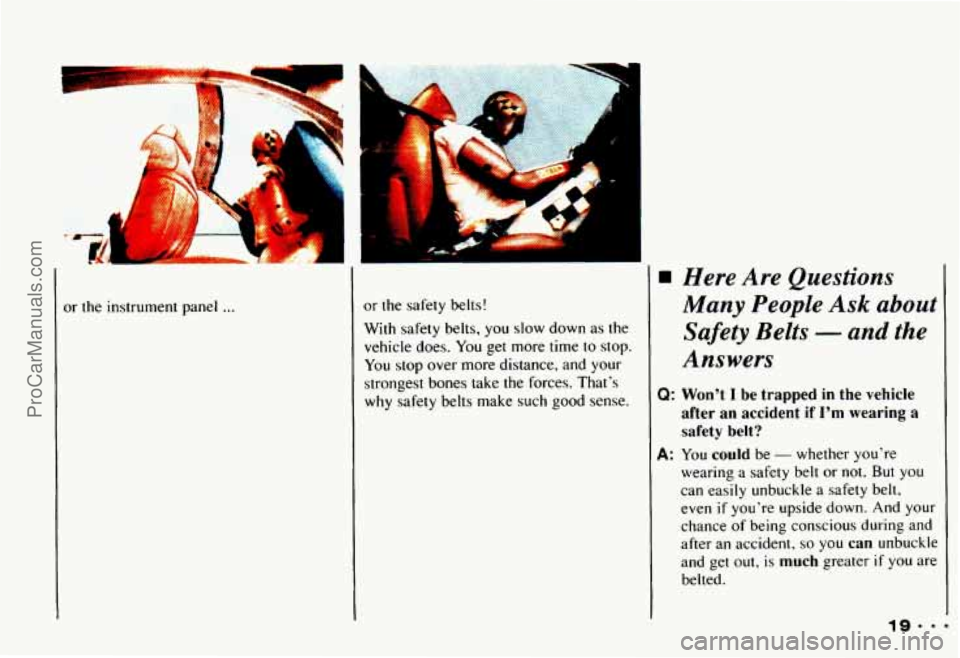
1
1
or the instrument panel ... or the safety belts!
With safety belts, you
slow down as the
vehicle does. You get more
time to stop.
You stop over more distance, and your
strongest bones take the forces. That’s
why safety
belts make such good sense.
Here Are Questions
Many People
Ask about
Safety Belts
- and the
Answers
Q: Won’t I be trapped in the vehicle
after an accident
if I’m wearing a
safety
belt?
A: You could be - whether you’re
wearing
a safety belt or not. But you
can easily unbuckle a safety belt,
even
if you’re upside down. And your
chance of being conscious during and
after an accident,
so you can unbuckle
and get out, is
much greater if you are
belted.
ProCarManuals.com
Page 30 of 358
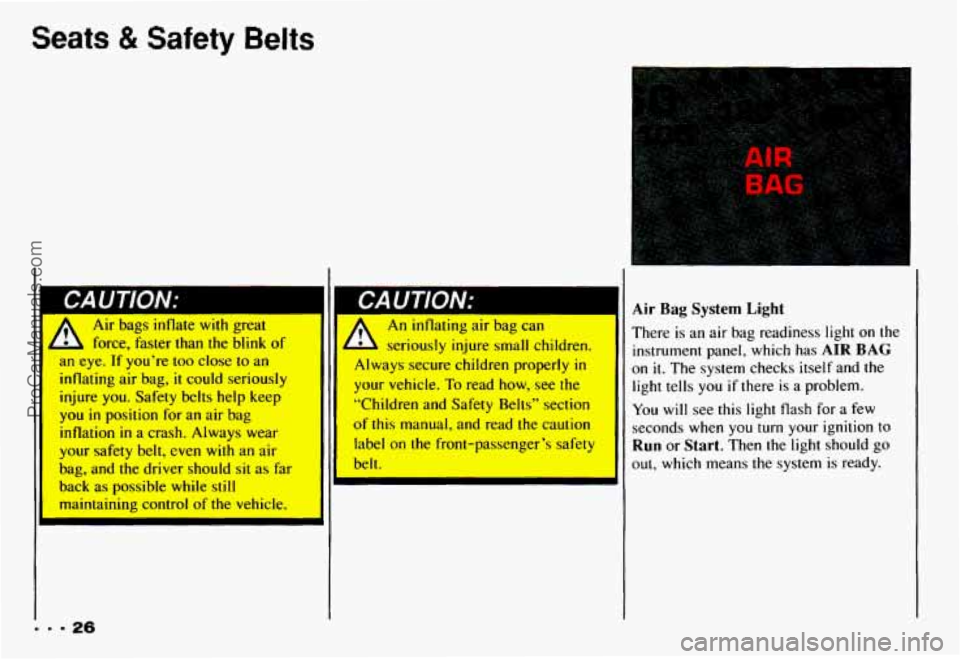
Seats & Safety Belts
A mr Dags inflate wltn great
b L force, faster than the blink of
ull eye. If you’re too close to an
inflating air bag,
it could seriously
injure
you. Safety belts help keep
you in position for an air bag
inflation in a crash. Always wear
your safety
belt, even with an air
bag, and the driver should sit as far
back as possible while still
maintaining control of the vehicle.
An mtlating air bag can
L seriously injure small children.
Always secure chiidren properly
in
your vehicle. To read how, see the
“‘Children and Safety Belts” section
of this manual, and read the caution
label on the front-passenger’s safety
belt.
I
,
r
Air Bag System Light
There is an air bag readiness light on the
instrument panel,
which has AIR BAG
on it. The system checks itself and the
light tells you
if there is a problem.
You
will see this light flash for a few
seconds when you turn your ignition to
Run or Start. Then the light should go
out, which means the system is ready.
ProCarManuals.com
Page 31 of 358
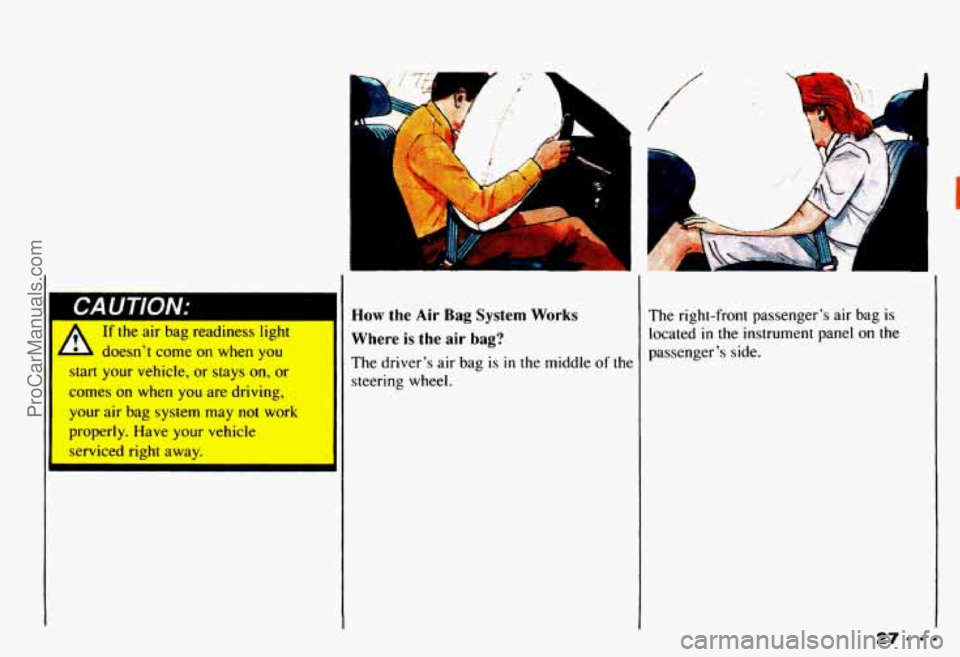
If the air bag readiness light
d b doesn’t come on when you
start your vehicle, or stays on, or
comes on when you are driving,
your air bag system may not work
properly. Have your vehicle
serviced right away.
I
1
How the Air Rag System Works
Where is the air bag?
The driver’s air bag is
in the middle of the
steering wheel.
Y
p
The right-front passenger’s air bag is located
in the instrument panel on the
passenger’s side.
ProCarManuals.com
Page 32 of 358
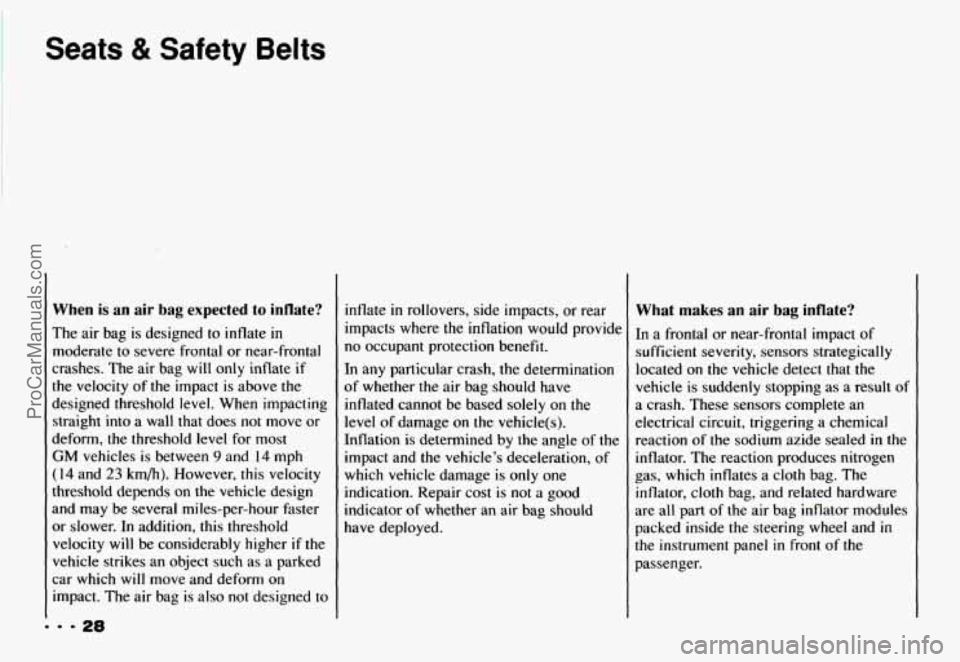
Seats & Safety Belts
When is an air bag expected to inflate?
The air bag is designed to inflate in
moderate to severe frontal or near-frontal
crashes. The air bag will only inflate
if
the velocity of the impact is above the
designed threshold level. When impacting straight into a wall that does not move or
deform, the threshold level for most
GM vehicles is between 9 and 14 mph
(14 and 23 km/h). However, this velocity
threshold depends
on the vehicle design
and may be several miles-per-hour faster
or slower. In addition, this threshold
velocity
will be considerably higher if the
vehicle strikes an object such as a parked
car which will move and deform on
impact. The air bag
is also not designed to inflate
in rollovers, side impacts, or rear
impacts where the inflation would provide
no occupant protection benefit.
In any particular crash, the determination
of whether the air bag should have
inflated cannot be based solely on the
level of damage on the vehicle(s).
Inflation is determined by the angle of the
impact and the vehicle’s deceleration, of
which vehicle damage is only one
indication. Repair cost
is not a good
indicator of whether an air bag should
have deployed.
What makes an air bag inflate?
In a frontal or near-frontal impact of
sufficient severity, sensors strategical
located on the vehicle detect that the
vehicle is suddenly stopping as a result of
a crash. These sensors complete an
electrical circuit, triggering a chemical
reaction of the sodium azide sealed
in the
inflator. The reaction produces nitrogen
gas, which inflates a cloth bag. The
inflator, cloth bag, and related hardware
are all part
of the air bag inflator modules
packed inside the steering wheel and
in
the instrument panel in front of the
passenger.
ProCarManuals.com
Page 33 of 358
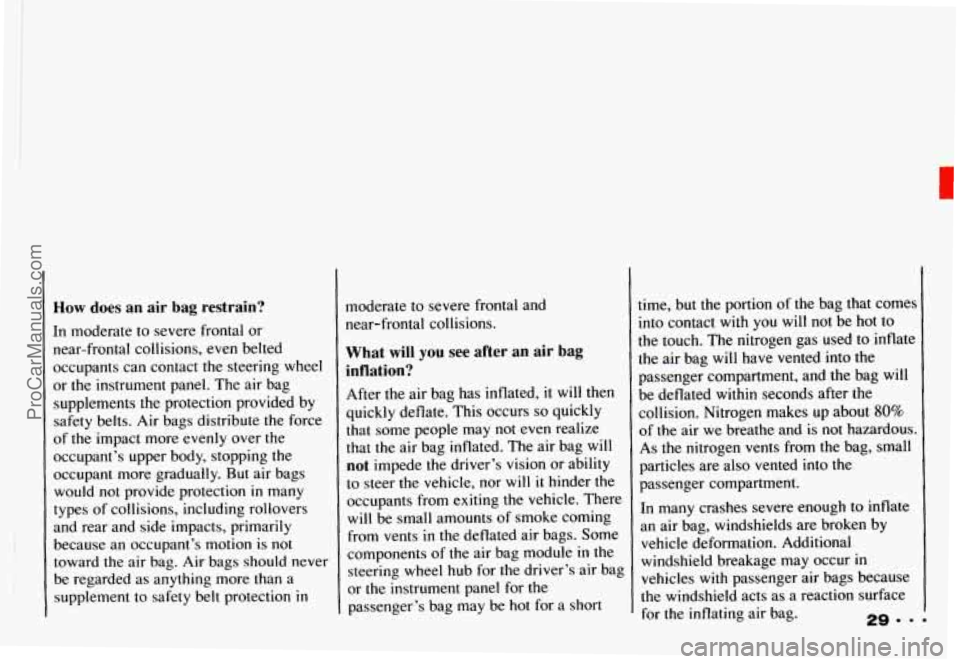
How does an air bag restrain?
[n moderate to severe frontal or
near-frontal collisions,
even belted
occupants can contact
the steering wheel
or the instrument panel. The air bag
supplements the protection provided by
safety belts. Air bags distribute the force
of the impact more evenly over the
occupant’s upper body, stopping the
occupant more gradually. But air bags
would not provide protection in many
types of collisions, including rollovers
and rear and side impacts, primarily
because an occupant’s motion
is not
toward
the air bag. Air bags should never
be regarded as anything more than a
supplement to safety belt protection
in
moderate to severe frontal and
near-frontal collisions.
What will you see after an air bag
inflation?
After the air bag has inflated, it will then
quickly deflate. This occurs
so quickly
that some people may not even realize
that the air bag inflated. The air bag will
not impede the driver’s vision or ability
to steer the vehicle, nor will
it hinder the
occupants from exiting the vehicle. There
will be small amounts of smoke coming
from vents
in the deflated air bags. Some
components of the air bag module
in the
steering wheel hub for the driver’s air bag
or the instrument panel for the
passenger’s bag may be hot for a short
t
1
t
t
I
1
4
1 1
r >
ime, but the portion of the bag that comes
nto contact with you will not be hot to
he touch. The nitrogen gas used to inflate _._ .~ ~
he air bag will have vented into the
Iassenger compartment, and the bag will
Je deflated within seconds after the
:ollision. Nitrogen makes
up about 80%
3f the air we breathe and is not hazardous.
As the nitrogen vents from the bag, small
particles are also vented into the
passenger compartment.
In many crashes severe enough to inflate
an air bag, windshields are broken by
vehicle deformation. Additional
windshield breakage may occur
in
vehicles with passenger air bags because
the windshield acts as a reaction surface
.~~ ~
for the inflating air bag. 29-9.
ProCarManuals.com
Page 34 of 358

Seats & Safety Belts
CAUTlON;
on’t attach anything to
~ :e steering wheel pad. It
0
0
0
-* 9 30
might injure thedriver if the
air bag inflates.
Don’t set anything on or attach
anything
to the instrument
panel.
It might injure the
passenger
if the air bag
inflates.
The air bags are designed
to
inflate only once. After they
inflate, you’ll need some new
parts for your air bag system.
If you don’t get them, the air
bag system won’t be there
to
help protect you in another
crash.
A new system will
include air bag modules and
possibly other parts.
Let only qualified technicians
work on you# air bag system.
Improper service can mean
that your air bag system
won’t
work properly. See your dealer
for service.
I
may not work properly. You may
have
to replace both the air bag a
%ak the air bag cover.
: instrument panel. Don’ pen or
Servicing Your Chevrolet with the Air
Bag System
Please tell or remind anyone who works
on your Chevrolet that it has the air bag
system. There are parts of the air bag
system
in several places around your
vehicle. You don’t want the system to
inflate while someone is working on your
vehicle. The air bag system does not need regular maintenance.
Your Chevrolet
dealer and the
1993 Camaro Service
Manual have information about the air
bag system, including repair
or disposal.
I A For up to 2 minutes after the
L ignition key is turned off and
the battery disconnected, an air bag
can still inflate during improper
service.
You can be injured if you
are close to an air bag when it
inflates. Be sure to follow the proper
service procedures.
ProCarManuals.com
Page 35 of 358
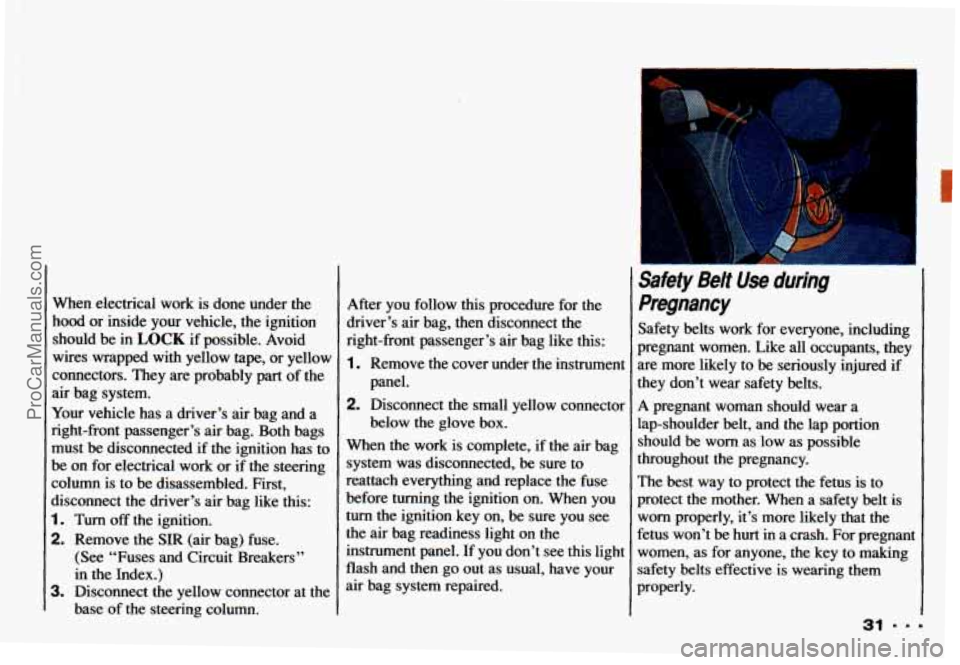
When electrical work is done under the
hood or inside your vehicle, the ignition
should be in
LOCK if possible. Avoid
wires wrapped with yellow tape, or yellow
connectors. They are probably part
of the
air bag system.
Your vehicle has a driver’s air bag and a
right-front passenger’s air bag. Both bags
must
be disconnected if the ignition has to
be on for electrical work or if the steering
column is to be disassembled. First,
disconnect the driver’s air bag like this:
1. Turn off the ignition.
2. Remove the SIR (air bag) fuse.
(See “Fuses and Circuit Breakers”
in the Index.)
3. Disconnect the yellow connector at the
base
of the steering column. After
you follow this procedure for the
jriver
’s air bag, then disconnect the
right-front passenger’s air bag like this:
1. Remove the cover under the instrument
2. Disconnect the small yellow connector
When the work is complete, if the air bag
system was disconnected, be sure to
reattach everything and replace
the fuse
before turning the ignition on. When you
turn the ignition key on, be sure you see
the air bag readiness light on the
instrument panel.
If you don’t see this lighl
flash and then go out as usual, have your
air bag system repaired.
panel.
below the glove box.
Safety Belt Use dumg
Pregnancy
Safety belts work for everyone, including
pregnant women. Like all occupants, they
are more likely to be seriously injured if
they don’t wear safety belts.
A pregnant woman should wear a
lap-shoulder belt, and the lap portion
should be worn as low as possible
throughout the pregnancy.
The best way to protect the fetus is to
protect the mother. When a safety belt is
worn properly, it’s more likely that the
fetus won’t be hurt in a crash. For pregnant
women, as for anyone, the key to making
safety belts effective is wearing them
properly.
31 ===
ProCarManuals.com
Page 51 of 358

Part 2
Features & Controls
Keys .............................................................. 48
.... DoorLocks ......................................................... 50
Theft .............................................................. 52
Here you can learn about the
many standard and optional
features on your Chevrolet. and
information
on starting. shifting
and braking
. Also explained are
the instrument panel and the
warning systems that tell you if
everything is working properly
-
and what to do if you have a
problem .
PASS-Key II@ ...................................................... 53
New Vehicle "Break-In" .............................................. 55
Ignitionswitch ...................................................... 55
Starting Your Engine ................................................. 57
Driving through Deep Standing Water
.................................... 61
Engine Block Heater
................................................. 61
Automatic Transmission .............................................. 62
ManualTransmission ................................................. 66
Limited-Slip Rear Axle
............................................... 70
Parking
............................................................ 70
EngineExhaust
..................................................... 74
Windows
.......................................................... 75
Horn
.............................................................. 76
Tiltwheel
.......................................................... 76
Operation of Lights
.................................................. 84
Interior Lights ...................................................... 86
Mirrors ............................................................ 87
Twin Lift-off Roof Panels
............................................. 88
Storage and Compartments ............................................ 92
Sunvisors
......................................................... 94
Ashtray and Lighter .................................................. 94
FloorMats ......................................................... 95
Instrument Panel and Cluster ........................................... 98
Warning Lights
. Gages and Indicators .................................... 99
47
The Turn Signal/Headlight Beam Lever .................................. 77
ProCarManuals.com